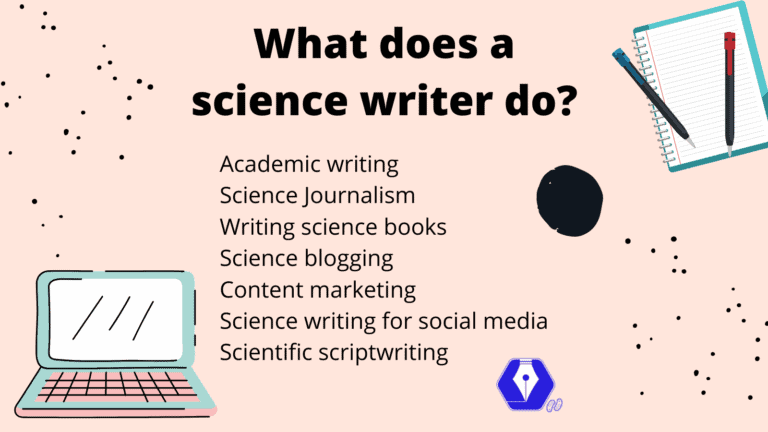Ever since I started telling the world that I am a science writer now, people have that look on their face “What does it mean?”
Okay, yes, you write about science? But how? Where? For whom?
These are valid questions.
Questions, I needed to answer myself to nail down what it is that I wanted to do.
And as I learned myself in the past year, a science writer can work on many different types of projects.
So, it is rather a question of what is science writing?
What is science writing?
Broadly, science writing is anything in which one writes about science-related topics for any kind of target audience. A science writer aims to educate the reader by breaking down a scientific concept, describing it in an appropriate way for the audience and putting it into context.
Generally, two forms of science writing exist depending on the intended audience: scholarly communication/writing or popular communication/writing.
Scholarly communication intends to educate fellow scientists on the specifics of a research finding or method. Popular science communication means to inform non-scientists more broadly about research findings.
Hence, someone who is writing for non-scientific audiences has multiple jobs:
- Understand the scientific publications written in academic language
- Translate the scientific article into a language understood by people outside of that field or non-scientists
- Write a story about science in a compelling and engaging way
The actual writing activity, however, can include many types and depends on the chosen format. This can be writing for scientific journals, books, magazines, blogs, social media, or even other media like television or podcasts.
Here, we will look at different forms of how science writers engage their audiences. This might give you an idea about what a science writer does.
Academic writing
In academic writing, scientific researchers aim to explain their latest research results to fellow scientists.
For this, they need to provide background on the research problem and explain the experiments that they did and why they chose to do them. They explain their results and discuss what these results could mean in the broader context of the research field and how other scientists can learn from these results. Usually, researchers then provide a bigger picture of the field and discuss which questions are still open.
Also writing literature reviews for a scientific journal is a form of science writing. This means that researchers read many publications on a scientific topic. They will then organise the results in a way that tell the reader a new story about an old problem. Often the writer collects new publications about a research topic and tells the reader what is new. Or several recent research publications point the field into a new direction that one publication on its own would not reveal. However, when looking at the bigger picture, it becomes clear.
So, maybe you as a researcher don’t see yourself as a science writer. And maybe you even think of hiring a science writer who focuses on academic writing. But as soon as you have written and published your first scientific publication, you can add academic science writer to your job title.
Science journalism
In general, popular science writing is meant to explain the latest science publications to broader audiences.
Often, science journalists explain the same scientific results as a researcher wrote in their academic paper. But in science journalism articles, you will find less jargon and barely any technical terms. These articles are meant to be understood by people outside of the scientific field.
Science journalists often additionally interview scientists to help them shape their science stories. And as a good practice, science journalists talk to researchers from the original study and maybe someone within the same field. This you will then see as quotes within the article and it helps the journalist to support their story. It also gives credibility to the researchers and scientific findings.
These kinds of articles you will find on online platforms dedicated to scientific topics, online magazines and print media (where it still exists).
Writing science books
Writing a science book is probably the longest-lasting form of science writing. In a book, an author can tell a complex story, influence culture or generate debates about specific topics.
Some researchers decide to write science books for other researchers explaining research methods or collecting the newest research data from a field. Many researchers and scientists have written a book or contributed to a science book during their research career. And often, various research groups work together on one book edition.
Some scientists also decide to research and write science books for non-scientists. However, one needs to be aware that they might still be written in a fairly technical manner and with a specific audience in mind. My favourite book in that category is “Deadly Companions” by Dorothy Crawford about how pandemics in the last centuries shaped human culture and historical events.
Also, many science journalists embark on writing popular science books. The most famous one in microbiology is probably Ed Yong’s “I contain multitudes” explaining how much microbes impact our lives.
Science blogging
Science blogging can look different depending on who you ask in terms of article length, intended audiences, seriousness or complexity. For example, a scientist could write about their daily life of being a scientist in a diary-like form.
Other scientists decided to educate their readers on their research field. Plus, they might discuss different scientific concepts or scientific publications in posts. These kinds of articles often appeal to both scientific and non-scientific audiences.
Science blogging gives you the most freedom when it comes to writing about science. You are not restricted in characters like on social media. No one gives you guidelines for formatting. And you alone can decide about the content of your posts – at least when it is your own blog.
As a blogger, you can decide to include science art to underline your articles and make them easier to understand. And you can decide how far you want to go with your blog, how often to post, how to advertise it and where to publish links to it.
So, if you are looking for a casual way to talk about your research or want to try out a new science communication or science writing project, I can recommend starting a blog. This will give you a great opportunity to learn about science writing, while also educating your readers.
Content marketing
Explaining a scientific product or the scientific process of producing a product is a great way to showcase the applications of science.
A company might have developed a new product or a health specialist advertises for a certain product on their site. To explain to their clients how their products could help them, they might hire a science writer. The two parties will then work closely together to develop an article that showcases the product and explains its scientific background.
Science writing for social media
Publishing scientific content on social media becomes more and more popular since the reader does not even need to leave the platform and has the content right at their fingertips.
You can embellish your posts with colourful and engaging videos or images to attract more followers and make the algorithms happy. And since there is a social media platform for any group these days, you can pick the one with the audience you want to connect with and start shouting!
Therefore, it is tempting to write about science on social media. However, your number of followers depends on the platform and its algorithms. And social media posts vanish from the online world faster than from any other platform. So, social media could give you the fastest-growing number of followers for your science writing work, it might not be the most sustainable one.
Scientific scriptwriter
Writing scientific scripts might be the most creative form of science writing. One can write scripts for films or documentations, podcasts or even comics. Any form of media that tells a story based on scientific concepts requires a (science) writer to sit down, go through research findings and think about a story.
Such projects always involve other people to realise the script content after the actual writing part. This would be a filmmaker or the person recording the podcast or the artist illustrating your science comic. Hence, you will need to work closely together with the person who will adapt your script. Out of experience, this can lead to super creative and engaging discussions.
What do science writers do?
As in every writing project, you want to intrigue your reader, inform them and tell them something new. Science writers do exactly the same, just that they specifically write about scientific concepts.
The fun thing is, that your reader could be anyone: another scientist, someone who came across your super cool blog or social media post or the 5-year-old that you’re writing that children’s book for.
Depending on who will read your piece, you will need to change your tone, your language and even your sentence structure.
So, science writers can come in many different flavours. They are talking to different audiences on different platforms. They might collaborate with others to produce supplementary pieces or work on their own. It seems that the possibilities for science writers – especially in an online world – are endless!
I have embarked on many of the above-mentioned science writing projects myself already and am looking forward to trying out some more! And I can’t wait to tell more science stories to different audiences on different platforms. It surely is an exciting field!


5 Responses